dashboard RENAULT KANGOO 2012 X61 / 2.G Owners Manual
[x] Cancel search | Manufacturer: RENAULT, Model Year: 2012, Model line: KANGOO, Model: RENAULT KANGOO 2012 X61 / 2.GPages: 237, PDF Size: 8.62 MB
Page 25 of 237
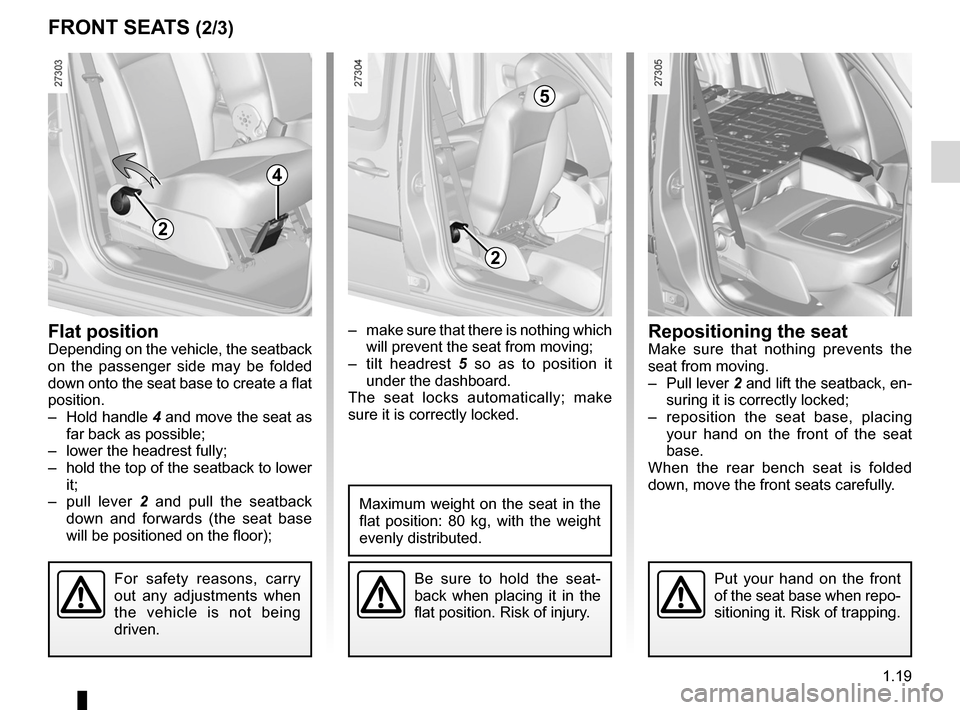
JauneNoirNoir texte
1.19
ENG_UD21409_6
Sièges avant (X61 - F61 - K61 - Renault)
ENG_NU_813-11_FK61_Renault_1
– make sure that there is nothing which
will prevent the seat from moving;
– tilt headrest 5 so as to position it
under the dashboard.
The seat locks automatically; make
sure it is correctly locked.Flat positionDepending on the vehicle, the seatback
on the passenger side may be folded
down onto the seat base to create a flat
position.
– Hold handle 4 and move the seat as
far back as possible;
– lower the headrest fully;
– hold the top of the seatback to lower
it;
– pull lever 2 and pull the seatback
down and forwards (the seat base
will be positioned on the floor);
Be sure to hold the seat -
back when placing it in the
flat position. Risk of injury.
Maximum weight on the seat in the
flat position: 80 kg, with the weight
evenly distributed.
FRONT SeATS (2/3)
4
2
2
5
For safety reasons, carry
out any adjustments when
the vehicle is not being
driven.Put your hand on the front
of the seat base when repo-
sitioning it. Risk of trapping.
Repositioning the seatMake sure that nothing prevents the
seat from moving.
– Pull lever 2 and lift the seatback, en-
suring it is correctly locked;
– reposition the seat base, placing
your hand on the front of the seat
base.
When the rear bench seat is folded
down, move the front seats carefully.
Page 36 of 237
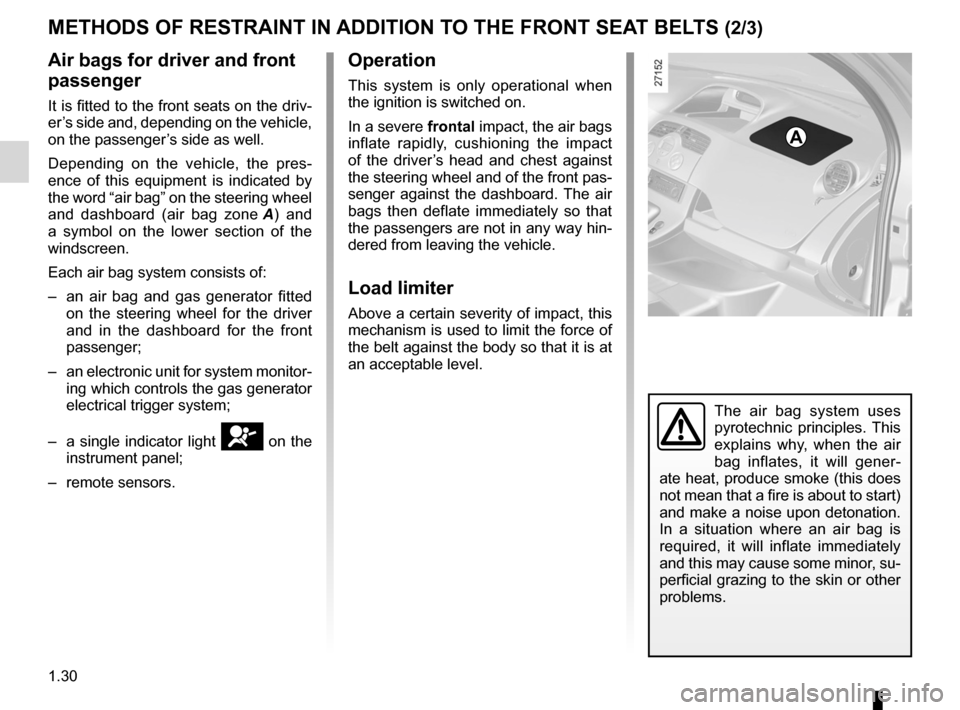
1.30
ENG_UD21590_3
Dispositifs complémentaires à la ceinture avant (X61 - F61 - K61 - Renault)
ENG_NU_813-11_FK61_Renault_1
Jaune NoirNoir texte
MeTHODS OF ReSTRAINT IN ADDITION TO THe FRONT SeAT BeLTS (2/3)
Air bags for driver and front
passenger
It is fitted to the front seats on the driv-
er’s side and, depending on the vehicle,
on the passenger’s side as well.
Depending on the vehicle, the pres -
ence of this equipment is indicated by
the word “air bag” on the steering wheel
and dashboard (air bag zone A ) and
a symbol on the lower section of the
windscreen.
Each air bag system consists of:
– an air bag and gas generator fitted
on the steering wheel for the driver
and in the dashboard for the front
passenger;
– an electronic unit for system monitor-
ing which controls the gas generator
electrical trigger system;
– a single indicator light
å on the
instrument panel;
– remote sensors.
A
Operation
This system is only operational when
the ignition is switched on.
In a severe frontal impact, the air bags
inflate rapidly, cushioning the impact
of the driver’s head and chest against
the steering wheel and of the front pas-
senger against the dashboard. The air
bags then deflate immediately so that
the passengers are not in any way hin-
dered from leaving the vehicle.
Load limiter
Above a certain severity of impact, this
mechanism is used to limit the force of
the belt against the body so that it is at
an acceptable level.
The air bag system uses
pyrotechnic principles. This
explains why, when the air
bag inflates, it will gener -
ate heat, produce smoke (this does
not mean that a fire is about to start)
and make a noise upon detonation.
In a situation where an air bag is
required, it will inflate immediately
and this may cause some minor, su-
perficial grazing to the skin or other
problems.
Page 37 of 237
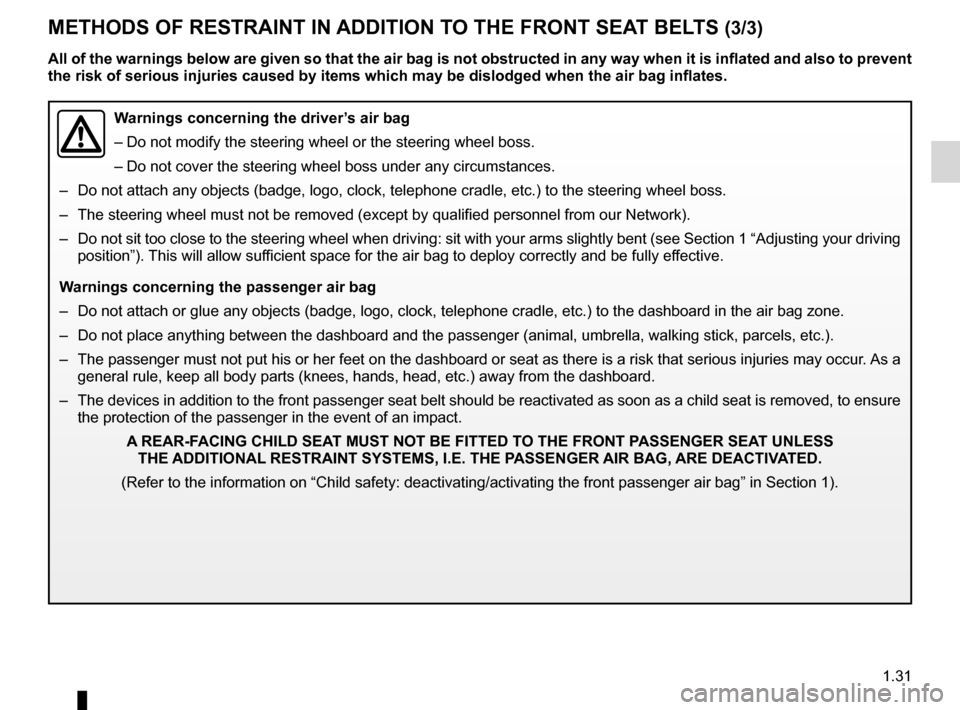
JauneNoirNoir texte
1.31
ENG_UD21590_3
Dispositifs complémentaires à la ceinture avant (X61 - F61 - K61 - Renault)
ENG_NU_813-11_FK61_Renault_1
MeTHODS OF ReSTRAINT IN ADDITION TO THe FRONT SeAT BeLTS (3/3)
Warnings concerning the driver’s air bag
– Do not modify the steering wheel or the steering wheel boss.
– Do not cover the steering wheel boss under any circumstances.
– Do not attach any objects (badge, logo, clock, telephone cradle, etc.) to the steering wheel boss.
– The steering wheel must not be removed (except by qualified personnel from our Network).
– Do not sit too close to the steering wheel when driving: sit with your arms slightly bent (see Section 1 “Adjusting your driving
position”). This will allow sufficient space for the air bag to deploy correctly and be fully effective.
Warnings concerning the passenger air bag
– Do not attach or glue any objects (badge, logo, clock, telephone cradle, etc.) to the dashboard in the air bag zone.
– Do not place anything between the dashboard and the passenger (animal, umbrella, walking stick, parcels, etc.).
– The passenger must not put his or her feet on the dashboard or seat as there is a risk that serious injuries may occur. As a
general rule, keep all body parts (knees, hands, head, etc.) away from the dashboard.
– The devices in addition to the front passenger seat belt should be reactivated as soon as a child seat is removed, to ensure
the protection of the passenger in the event of an impact.
A ReAR-FACING CHILD SeAT MUST NOT Be FITTeD TO THe FRONT p ASSeNGeR SeAT UNLeSS
THe ADDITIONAL ReSTRAINT SySTeMS, I.e. THe p ASSeNGeR AIR BAG, ARe DeACTIvATeD.
(Refer to the information on “Child safety: deactivating/activating the front passenger air bag” in Section 1).
All of the warnings below are given so that the air bag is not obstructed in any way when it is inflated and also to prevent
the risk of serious injuries caused by items which may be dislodged when the air bag inflates.
Page 51 of 237
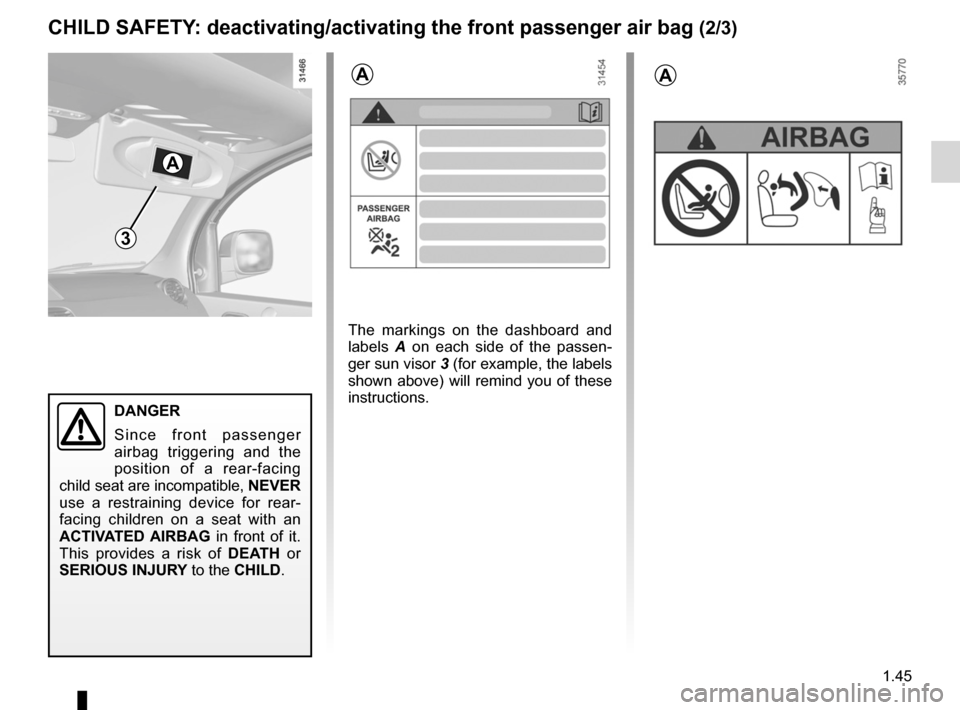
JauneNoirNoir texte
1.45
ENG_UD29619_5
Sécurité enfants : désactivation/activation airbag passager avant (X61 - F61 - K61 - Renault)
ENG_NU_813-11_FK61_Renault_1
CHILD SAFeTy: deactivating/activating the front passenger air bag (2/3)
3
A
The markings on the dashboard and
labels A on each side of the passen -
ger sun visor 3 (for example, the labels
shown above) will remind you of these
instructions.
AA
DANGeR
S i n c e f r o n t p a s s e n g e r
airbag triggering and the
position of a rear-facing
child seat are incompatible, NeveR
use a restraining device for rear -
facing children on a seat with an
ACTI vAT eD AIRBAG in front of it.
This provides a risk of DeATH or
SeRIOUS INJUR y to the CHILD.
Page 54 of 237
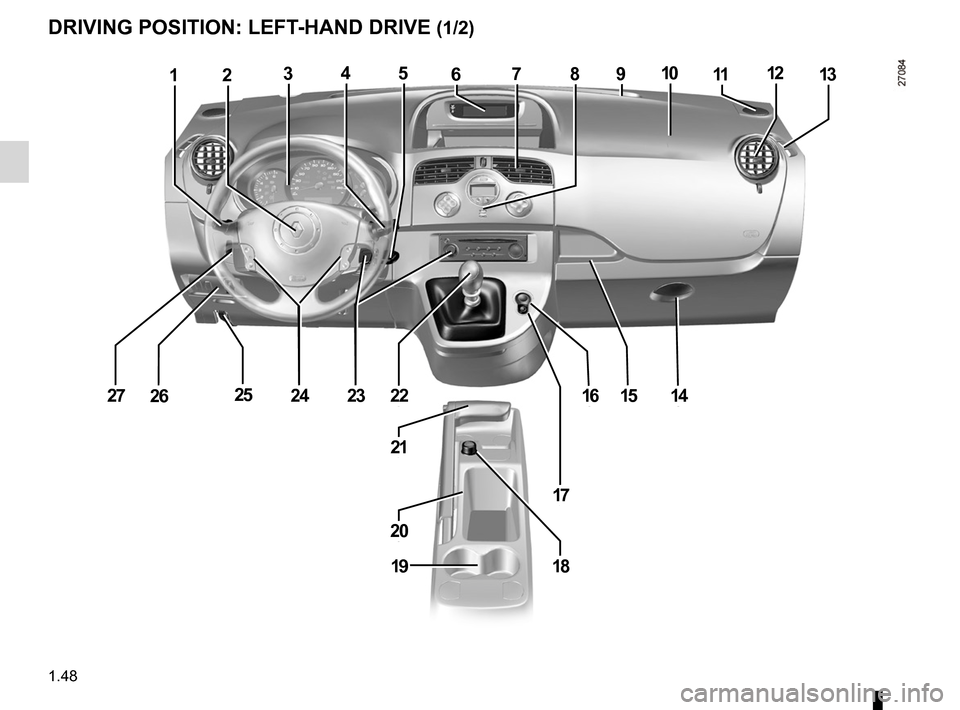
driver’s position .................................... (up to the end of the DU)
dashboard ............................................. (up to the end of the DU)
1.48
ENG_UD26237_5
Poste de conduite direction à gauche (X61 - F61 - K61 - Renault)
ENG_NU_813-11_FK61_Renault_1
Jaune NoirNoir texte
Driving position
DRIvING pOSITION: LeFT -HAND DRIve (1/2)
4613
1422
21
312
16
111
17
20
18
25
2781095
19
2415272326
Page 61 of 237
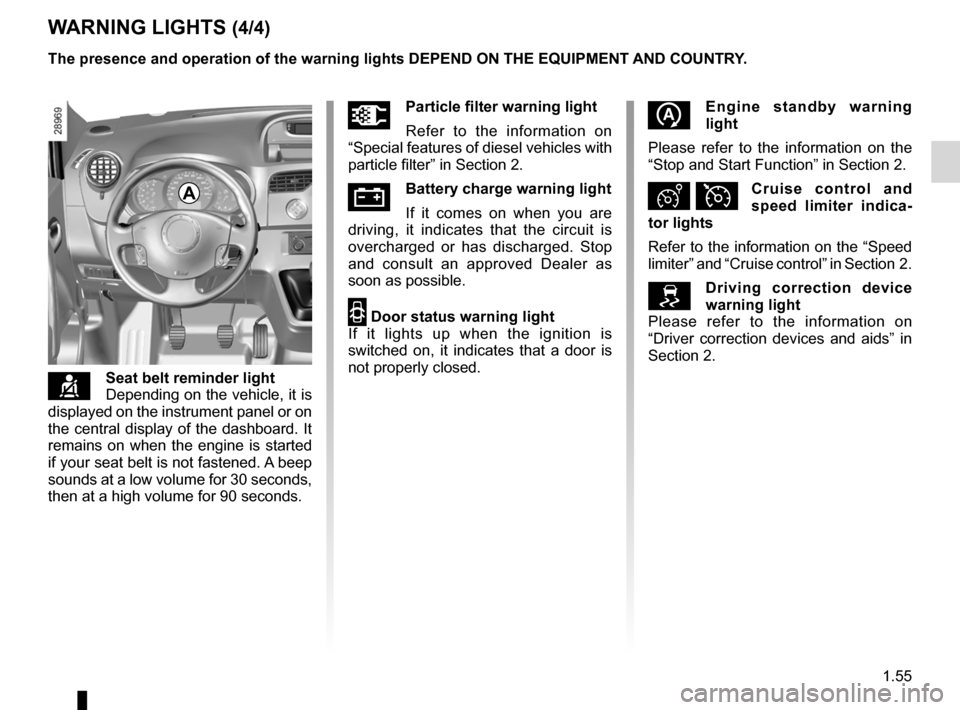
JauneNoirNoir texte
1.55
ENG_UD24365_6
Tableau de bord : témoins lumineux (X61 - F61 - K61 - Renault)
ENG_NU_813-11_FK61_Renault_1
WARNING LIGHTS (4/4)
çSeat belt reminder light
Depending on the vehicle, it is
displayed on the instrument panel or on
the central display of the dashboard. It
remains on when the engine is started
if your seat belt is not fastened. A beep
sounds at a low volume for 30 seconds,
then at a high volume for 90 seconds.
A
The presence and operation of the warning lights DepeND ON THe eQUIpMeNT AND COUNTR y.
Üparticle filter warning light
Refer to the information on
“Special features of diesel vehicles with
particle filter” in Section 2.
ÚBattery charge warning light
If it comes on when you are
driving, it indicates that the circuit is
overcharged or has discharged. Stop
and consult an approved Dealer as
soon as possible.
2 Door status warning light
If it lights up when the ignition is
switched on, it indicates that a door is
not properly closed.
e ngine standby warning
light
Please refer to the information on the
“Stop and Start Function” in Section 2.
Ð ÏCruise control and
speed limiter indica -
tor lights
Refer to the information on the “Speed
limiter” and “Cruise control” in Section 2.
Driving correction device
warning light
Please refer to the information on
“Driver correction devices and aids” in
Section 2.
Page 121 of 237
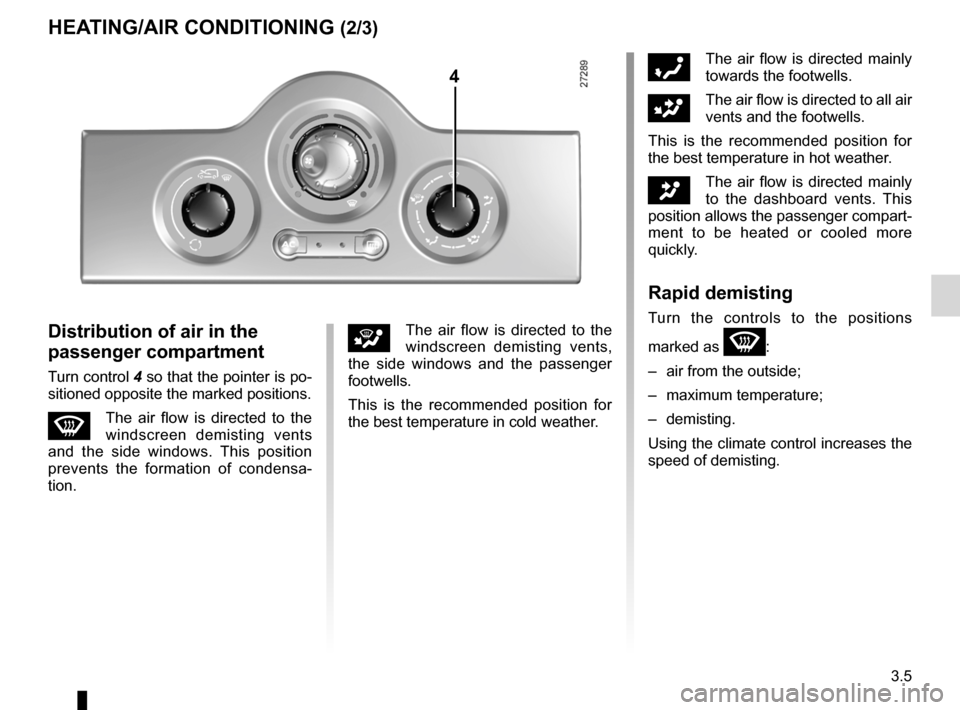
demistingwindscreen ....................................................... (current page)
JauneNoirNoir texte
3.5
ENG_UD12366_3
Chauffage / Air conditionné (X61 - F61 - K61 - X61 BUp - Renault)
ENG_NU_813-11_FK61_Renault_3
óThe air flow is directed mainly
towards the footwells.
GThe air flow is directed to all air
vents and the footwells.
This is the recommended position for
the best temperature in hot weather.
JThe air flow is directed mainly
to the dashboard vents. This
position allows the passenger compart-
ment to be heated or cooled more
quickly.
rapid demisting
Turn the controls to the positions
marked as
W:
– air from the outside;
– maximum temperature;
– demisting.
Using the climate control increases the
speed of demisting.iThe air flow is directed to the
windscreen demisting vents,
the side windows and the passenger
footwells.
This is the recommended position for
the best temperature in cold weather.
HeA tinG/Air COnDitiOninG (2/3)
Distribution of air in the
passenger compartment
Turn control 4 so that the pointer is po-
sitioned opposite the marked positions.
WThe air flow is directed to the
windscreen demisting vents
and the side windows. This position
prevents the formation of condensa -
tion.
4
Page 126 of 237
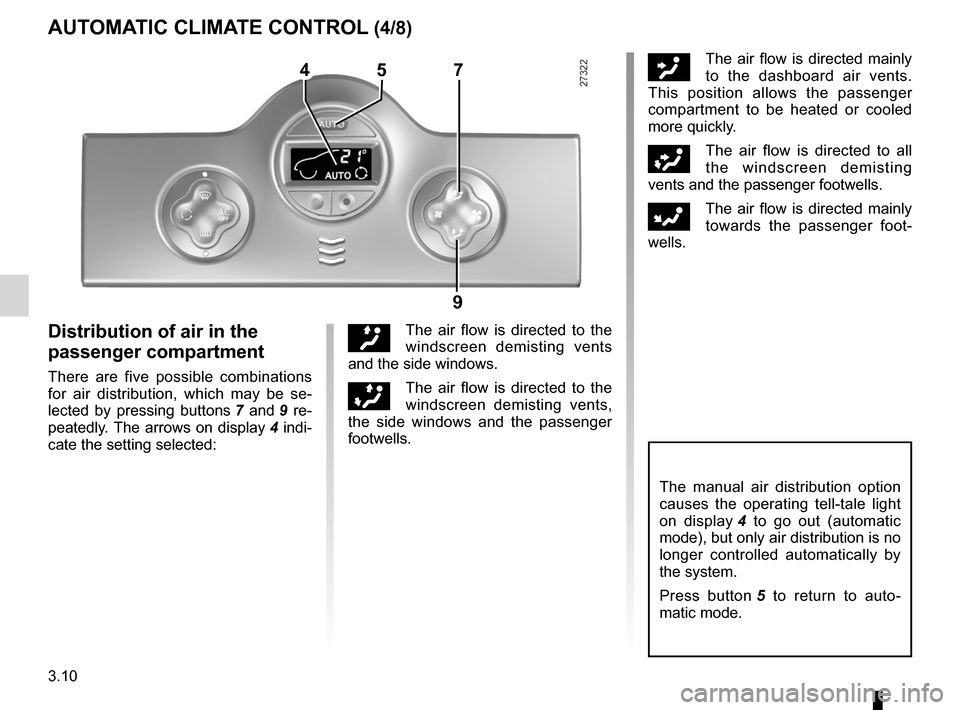
3.10
ENG_UD10847_2
Air conditionné automatique (X61 - F61 - K61 - X61 BUp - Renault)
ENG_NU_813-11_FK61_Renault_3
Jaune NoirNoir texte
ôThe air flow is directed mainly
to the dashboard air vents.
This position allows the passenger
compartment to be heated or cooled
more quickly.
öThe air flow is directed to all
the windscreen demisting
vents and the passenger footwells.
FThe air flow is directed mainly
towards the passenger foot -
wells.
The manual air distribution option
causes the operating tell-tale light
on display 4 to go out (automatic
mode), but only air distribution is no
longer controlled automatically by
the system.
Press button 5 to return to auto -
matic mode.
Distribution of air in the
passenger compartment
There are five possible combinations
for air distribution, which may be se -
lected by pressing buttons 7 and 9 re -
peatedly. The arrows on display 4 indi-
cate the setting selected:
AUt OMA tiC CLiMA te COntrOL (4/8)
õThe air flow is directed to the
windscreen demisting vents
and the side windows.
÷The air flow is directed to the
windscreen demisting vents,
the side windows and the passenger
footwells.
47
9
5
Page 139 of 237
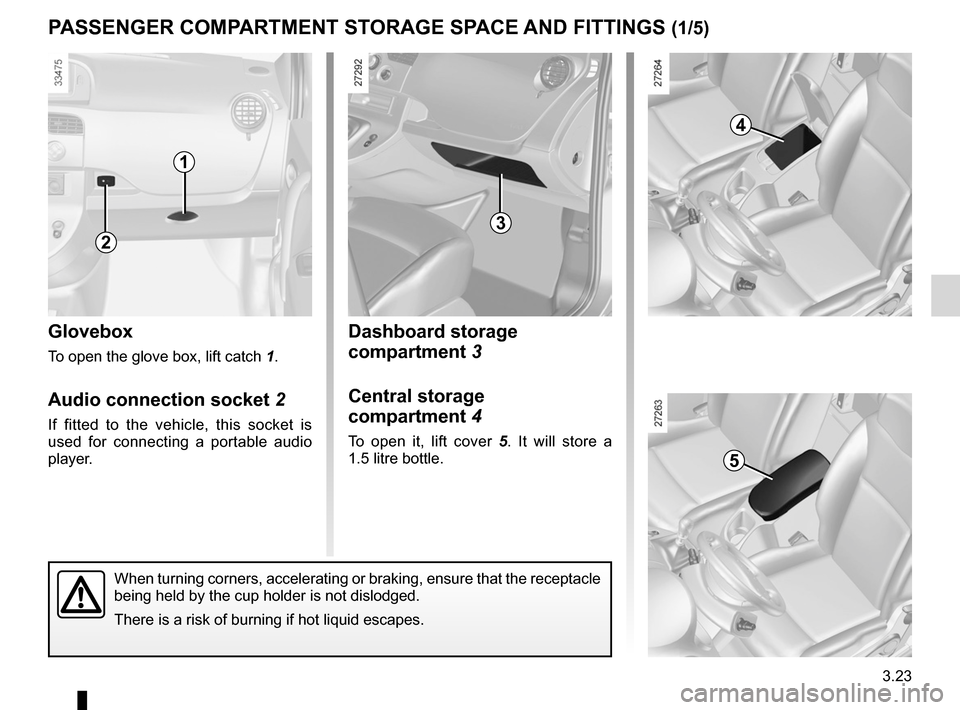
storage compartments .......................... (up to the end of the DU)
fittings ................................................... (up to the end of the DU)
glove box ............................................................... (current page)
storage compartment ............................(up to the end of the DU)
3.23
ENG_UD23542_3
Rangements / Aménagements habitacle (X61 - F61 - K61 - Renault)
ENG_NU_813-11_FK61_Renault_3
Passenger compartment storage space and fittings
Dashboard storage
compartment 3
Central storage
compartment 4
To open it, lift cover 5 . It will store a
1.5 litre bottle.
Glovebox
To open the glove box, lift catch 1.
Audio connection socket 2
If fitted to the vehicle, this socket is
used for connecting a portable audio
player.
PAssenGer COMPArtMent st OrAGe sPACe AnD FittinGs (1/5)
1
3
5
4
When turning corners, accelerating or braking, ensure that the receptacle
being held by the cup holder is not dislodged.
There is a risk of burning if hot liquid escapes.
2
Page 154 of 237
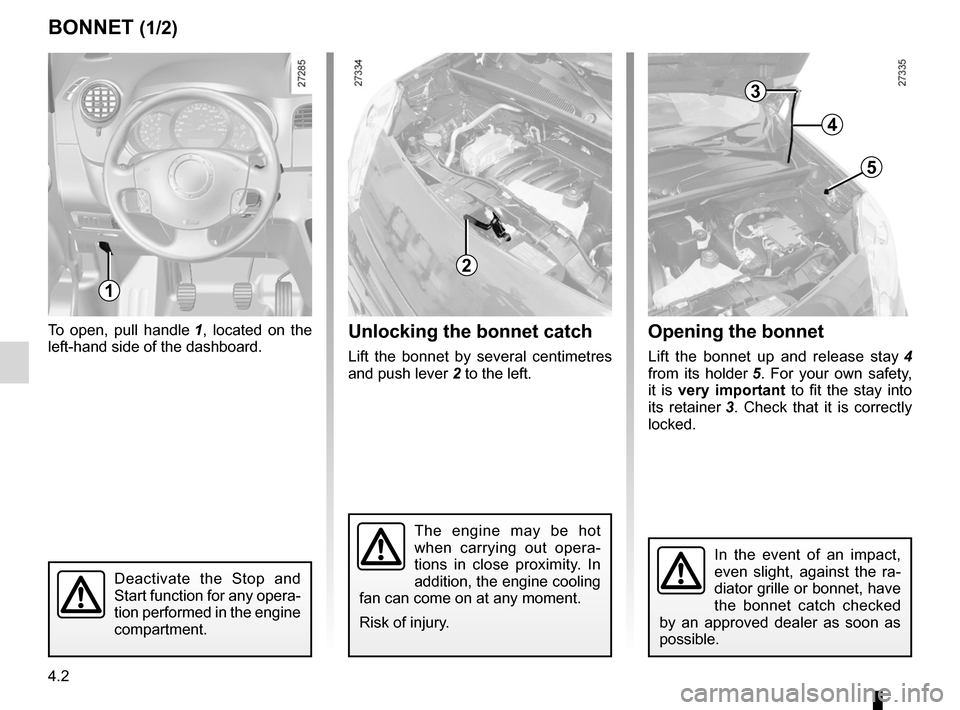
bonnet................................................... (up to the end of the DU)
maintenance: mechanical ...................................... (up to the end of the DU)
4.2
ENG_UD25823_5
Capot moteur (X61 - F61 - K61 - Renault)
ENG_NU_813-11_FK61_Renault_4
Jaune NoirNoir texte
To open, pull handle 1 , located on the
left-hand side of the dashboard.Unlocking the bonnet catch
Lift the bonnet by several centimetres
and push lever 2 to the left.
Bonnet
Bonnet (1/2)
The engine may be hot
when carrying out opera -
tions in close proximity. In
addition, the engine cooling
fan can come on at any moment.
Risk of injury.
1
2
In the event of an impact,
even slight, against the ra -
diator grille or bonnet, have
the bonnet catch checked
by an approved dealer as soon as
possible.
4
5
3
Deactivate the Stop and
Start function for any opera -
tion performed in the engine
compartment.
opening the bonnet
Lift the bonnet up and release stay 4
from its holder 5 . For your own safety,
it is very important to fit the stay into
its retainer 3 . Check that it is correctly
locked.